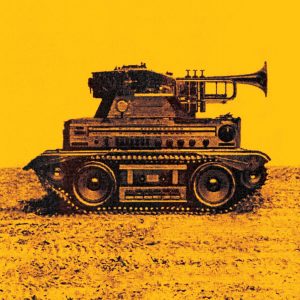From trumpets at the walls of Jericho to pop songs as torture in the Iraq War, sound can make a powerful weapon. In December, 1989, the Panamanian dictator Manuel Noriega was expelled from power by American forces. To escape capture, he took refuge in the Papal Nunciatura in Panama City. When an American general arrived to confer with the papal nuncio, the U.S. Army blared music from loudspeakers to prevent journalists from eavesdropping. Members of a psychological-operations unit then decided that non-stop music might aggravate Noriega into surrendering. They made requests for songs on the local armed-forces radio station, and directed the din at Noriega’s window. The dictator was thought to prefer opera, and so hard rock dominated the playlist. The songs conveyed threatening, sometimes mocking messages: Alice Cooper’s “No More Mr. Nice Guy,” AC/DC’s “You Shook Me All Night Long.”
Although the media delighted in the spectacle, President George H. W. Bush and General Colin Powell, then the chairman of the Joint Chiefs of Staff, took a dim view of it. Bush called the campaign “irritating and petty,” and Powell had it stopped. Noriega, who had received psy-ops training at Fort Bragg in the nineteen-sixties, is said to have slept soundly through the clamor. Nonetheless, military and law-enforcement officials became convinced that they had stumbled on a valuable tactic. “Since the Noriega incident, you’ve been seeing an increased use of loudspeakers,” a psyops spokesman declared. During the siege of the Branch Davidian compound, in Waco, Texas, in 1993, the F.B.I. blasted music and noise day and night. When Palestinian militants occupied the Church of the Nativity, in Bethlehem, in 2002, Israeli forces reportedly tried to eject them with heavy metal. And during the occupation of Iraq the C.I.A. added music to the torture regime known as “enhanced interrogation.” At Guantánamo, detainees were stripped to their underwear, shackled to chairs, and blinded by strobe lights as heavy metal, rap, and children’s tunes assaulted their ears. Music has accompanied acts of war since trumpets sounded at the walls of Jericho, but in recent decades it has been weaponized as never before—outfitted for the unreal landscape of modern battle.
The intersection of music and violence has inspired a spate of academic studies. On my desk is a bleak stack of books examining torture and harassment, the playlists of Iraq War soldiers and interrogators, musical tactics in American crime-prevention efforts, sonic cruelties inflicted in the Holocaust and other genocides, the musical preferences of Al Qaeda militants and neo-Nazi skinheads. There is also a new translation, by Matthew Amos and Fredrick Rönnbäck, of Pascal Quignard’s 1996 book, “The Hatred of Music” (Yale), which explores age-old associations between music and barbarity.
When music is applied to warlike ends, we tend to believe that it has been turned against its innocent nature. To quote the standard platitudes, it has charms to soothe a savage breast; it is the food of love; it brings us together and sets us free. We resist evidence suggesting that music can cloud reason, stir rage, cause pain, even kill. Footnoted treatises on the dark side of music are unlikely to sell as well as the cheery pop-science books that tout music’s ability to make us smarter, happier, and more productive. Yet they probably bring us closer to the true function of music in the evolution of human civilization.
A striking passage in J. Martin Daughtry’s “Listening to War: Sound, Music, Trauma, and Survival in Wartime Iraq” (Oxford) evokes the sound of the battlefield in the most recent Iraq war:
The growl of the Humvee engine. The thump-thump-thump of the approaching helicopter. The drone of the generator. Human voices shouting, crying, asking questions in a foreign tongue. “Allahu akbar!”: the call to prayer. “Down on the ground!”: the shouted command. The dadadadadada of automatic weapon fire. The shhhhhhhhhhhhh of the rocket in flight. The fffft of the bullet displacing air. The sharp k-k-k-k-r-boom of the mortar. The rolling BOOM of the I.E.D.
Read the whole article here:
http://www.newyorker.com/magazine/2016/07/04/when-music-is-violence
By Alex Ross
Alex Ross has been contributing to The New Yorker since 1993, and he became the magazine’s music critic in 1996.
This article appears in other versions of the July 4, 2016, issue, with the headline “The Sound of Hate.”
[Thank you to Alex Teitz, http://www.femmusic.com, for contributing this article.]

